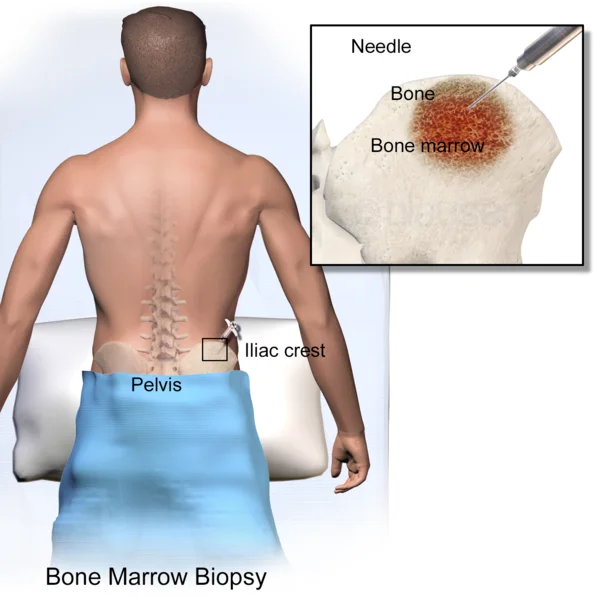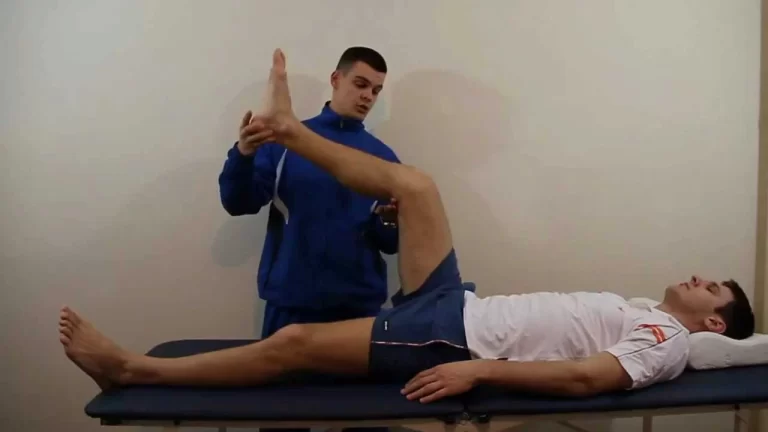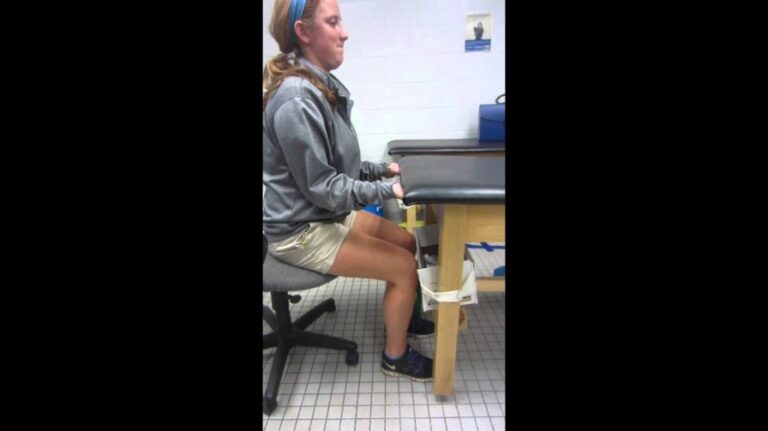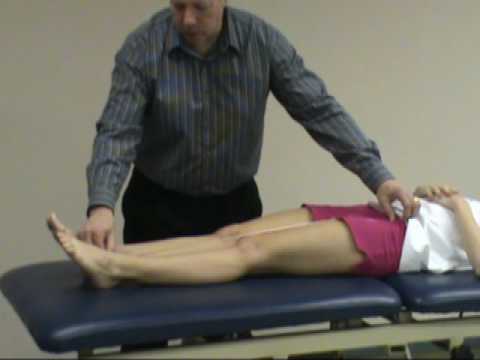Bone Marrow Biopsy
Introduction
The extraction of marrow from an internal bone is known as a bone marrow biopsy. The soft tissue that forms bone marrow aids in the production of red blood cells. The hollow portion of most bones contains it.
A bone marrow biopsy is the process of taking a tiny sample of your bone’s internal bone marrow for analysis. Most large bones include a soft tissue called bone marrow in the core. Most blood cells in the body are made by it.
A little needle that is put into the bone is used to do the biopsy. After being extracted, the bone marrow tissue is transferred to a lab to be examined under a microscope. Before the biopsy, you might receive an injection (shot) of a local anesthetic. This will cause the area to numb, relieving your agony.
A bone marrow biopsy is not the same as an aspiration of the bone marrow. A tiny amount of liquid bone marrow is removed during an aspiration to be examined.
Bone marrow
The human body’s supporting bone skeleton, which also makes movement easier, has a complex microarchitecture all its own. Adipocytes and blood cells from a wide variety of developmental stages occupy the cavities formed by the trabecular architecture of the bone core. This substance is referred to as bone marrow, and it is in charge of hematopoiesis, the process that produces new blood cells.
Your bone marrow is located in the hollow middle of your bigger bones. The tissue that makes up bone marrow is soft, liquid, and sponge-like.

The bone marrow’s tissue component generates:
- Red blood cells: oxygen-transporting cells in your body.
- White blood cells: cells that defend the body from pathogens and infectious conditions.
- Platelets: cells that, when your blood vessels are damaged, coagulate to stop the bleeding. The tubes that carry blood throughout your body are called blood vessels, and they include veins, arteries, and capillaries.
The liquid part of bone marrow contains stem cells or growing blood cells. It is also responsible for producing vitamins needed for cell development.
An alternative procedure called a bone marrow aspiration looks at the liquid part of your bone marrow, while a bone marrow biopsy looks at the tissue part. On the day of the procedure, your doctor will most likely take a bone marrow sample just before the biopsy.
Bone Marrow Properties
- A section of the lymphatic network.
- Is the pliable, soft tissue found inside bone cavities.
- About 4% of an adult human’s weight, or 2.6 kg, is made up of bone marrow.
- Highly vascularized and richly innervated tissue.
- The four main roles are hemostasis, protection against foreign invasion, oxygen transport, and hematopoiesis.
- Aids in the elimination of aging cells from the body.
- Possesses both a non-vascular and a vascular component.
- Red and yellow marrow are the two main forms of bone marrow tissue.
Location Of Bone Marrow Biopsy
The posterior iliac crest, or rear of the hipbone, is typically the site of bone marrow biopsies. The sternum, or breastbone, can also be used to obtain an aspirate. The patient rests on their back and elevates their chest with a pillow under their shoulder during sternal aspiration. The sternum is not the appropriate site for a trephine biopsy since there is a chance that the heart, lungs, or blood vessels could get hurt.
In children under two years old, bone marrow biopsies can also be done on the tibial (shinbone) location, but spinous process aspiration is usually done on the L3-L4 vertebrae and in a lumbar puncture position.
To lessen discomfort at the site of the needle insertion, anesthesia is employed. Short-term discomfort from the anesthetic process itself may coexist with pain from the procedure’s injury to the marrow, which cannot be sedated. The experience varies; some individuals report no pain at expected times, while others describe pain at varying degrees.
Why Is It Performed?
Your blood cells and bone marrow status can be thoroughly examined during a bone marrow exam. If blood tests are abnormal or don’t give enough information about a suspected condition, your doctor could schedule a bone marrow exam.
A bone marrow examination may be done by your doctor to:
- Assessor or analyzes condition: A bone marrow biopsy may be recommended by your healthcare professional if a blood sample shows an unusually high concentration of blood cells. They can diagnose blood diseases, cancer, infections, and other illnesses with the use of a biopsy.
- Stage cancer: The stage of cancer indicates how far along it has gone. If your cancer has progressed to your bone marrow, a bone marrow biopsy can reveal this. It can reveal whether a bone marrow malignancy is expanding.
- Monitor treatment progress: A bone marrow biopsy could be done by your doctor to assess the efficacy of your treatment. For instance, if you are receiving cancer treatment, you might have routine bone marrow biopsies. If your bone marrow generates enough healthy blood cells following treatment, the data may indicate this.
- Determining whether a donor is a suitable candidate for an allogeneic stem cell transplant also can be done by a bone marrow biopsy. A person who has too few healthy blood cells occasionally needs fresh, healthy stem cells from a donor. The donor and recipient’s cells must match for this to occur.
- Determine the ailment affecting the blood cells or bone marrow.
- Identify the disease’s stage or duration
- Check to see if your iron levels are sufficient.
- Keep an eye on a disease’s therapy
- Examine a fever with no apparent cause.
Risks
Exams of the bone marrow are usually safe procedures. Although rare, complications can include:
- excessive bleeding, especially in those with low levels of platelets, a specific type of blood cell
- infection, usually of the skin at the examination site, particularly in immunocompromised individuals
- persistent pain at the site of the bone marrow examination
- In rare cases, sternal aspirations might penetrate the breastbone (sternum), which can result in lung or heart issues.
Indications
A bone marrow biopsy may be performed by your physician to identify disorders affecting an excess or deficiency of blood cells. Cancers affecting your bone marrow or blood can also be diagnosed by bone marrow biopsies.
Some conditions are:
- Anemia: A disorder where the body lacks sufficient red blood cells to distribute oxygen throughout the body.
- Aplastic anemia: A disorder in which the bone marrow is unable to generate enough platelets, white blood cells, and red blood cells.
- Leukopenia and leukocytosis: Disorders characterized by an excess or shortage of white blood cells.
- Thrombocytopenia and thrombocytosis: Disorders involving excess or shortage of platelets.
- Polycythemia vera: A rare kind of blood cancer that produces an excessive amount of red blood cells in the bone marrow.
- Leukemia: Blood cell cancer, particularly in the case of white blood cells, can result in aberrant blood cells.
- Lymphoma: A lymphatic system tumor may cause an excessive production of white and red blood cells.
- Multiple myeloma: An uncommon malignancy of the blood that damages your plasma cells. One kind of white blood cell is a plasma cell.
- Secondary cancers: Cancer that begins in another part of your body (like breast or lung cancer) and then moves to another part of your body (like your bone marrow).
- Myelofibrosis: A condition when bone marrow is replaced by fibrous scar tissue.
- Myelodysplastic syndrome: A disease of the bone marrow when stem cells fail to mature appropriately.
- A bone marrow biopsy can also identify vitamin shortages and chromosomal abnormalities, which might cause your bone marrow to create too many or misshaped red blood cells.
Contraindications
Severe bleeding disorders, such as severe hemophilia or severe disseminated intravascular coagulopathy, are absolute contraindications to bone marrow biopsy. Thrombocytopenia does not preclude the use of platelets, and if necessary, If the patient’s platelet counts are below 20,000 cells/microliter, a transfusion may be given before the procedure.
Patients who are older than 12 years old should be the only ones to attempt sternum aspiration. Due to the risk of perforating the sternum and subsequently the mediastinum, patients with diffuse bone resorption brought on by metabolic or lytic processes, such as those with multiple myeloma, should be aspirated at the iliac crests rather than the sternum. For the same reasons, sternum biopsies are never recommended, even in individuals with strong bones.
Equipment
If necessary, a computed tomography (CT) scanner may be used. When the procedure is carried out by an interventional radiologist, this is frequently the case.
The following should be included in a bone marrow kit:
- Draperies that are sterile
- Needles
- A needle used for aspiration
- A needle is used for biopsies. When taking a biopsy on the posterior iliac crest, a Jamshidi needle is frequently used.
- 1%–2% lidocaine, either with or without adrenaline
- Slides of specimens
- Additionally, specimen containers will be needed. Depending on the type of pathology being investigated and whether a biopsy will be done in addition to the aspiration, different numbers of pathology slides and specimen containers will be needed.
Who performs a bone marrow biopsy?
A CT technician, nursing staff, and the doctor doing the procedure (or, in the case of the CT-guided technique, the patient) should be present at all times. If the patient is under general anesthesia or requires conscious sedation, the presence of an anesthesiologist or other certified professional may be required, depending on the policies of the hospital. It is often useful to have an assistant while arranging the slides for the bone marrow aspirates and a container for the biopsy samples.
Preparation
In addition to having your heart rate and blood pressure monitored, you’ll receive an anesthetic to ensure your comfort.
Just local anesthetic can be used to numb the area where the needles will be put during a bone marrow investigation. For instance, bone marrow aspiration might induce transient, intense discomfort when under local anesthetic. A lot of people decide to get mild sedation in addition to extra pain management.
You might receive an IV medicine to make you entirely or partially unconscious during the bone marrow examination if you’re afraid of pain.
The biopsy needle insertion site is noted and disinfected with an antiseptic. The posterior iliac crest, or upper ridge of the hipbone, is typically where the bone marrow fluid (aspirate) and tissue sample (biopsy) are taken. The front of the hip may be utilized occasionally.
Your body will be covered with cloth so that only the exam location is visible when you are instructed to lie on your side or abdomen.
Your healthcare practitioner will walk you through the process and give you preparation tips. For example, you might have to fast (have no food or liquids) the night before if you are given a sedative to aid with the pain the day of the treatment. You’ll be required to arrange for transportation home.
Your medical history and current prescriptions should be fully disclosed to your provider. Inform them of:
- Any prior bleeding issues (hemophilia, for example).
- Anything you take regularly, particularly blood thinners (anticoagulants).
- What supplements or vitamins do you take?
- Allergy to any medications?
- Your healthcare provider must also be informed if you are pregnant.
If you require medicine to help you relax because you are extremely anxious about the operation
It’s a good idea to bring someone with you on the day of the surgery. particularly if you’re taking medicine, such as sedatives, to aid in relaxation—though this isn’t normally necessary. After taking these drugs, you shouldn’t drive since they can make you feel sleepy.
Before the procedure, do everything your doctor instructs you to do. Before treatment, your doctor could advise you to cease using a certain drug. However, you should never discontinue taking medication unless directed to do so by your physician.
A good night’s sleep and arriving at your appointment on time or early will also help you feel less anxious before the biopsy.
Pain Preparation
According to reports from Trusted Source, the discomfort following the biopsy is typically mild, average, and less than expected. According to some research, the length and complexity of a biopsy are related to how painful it is. When a skilled physician completes the biopsy in less than ten minutes, the patient experiences far less pain.
Your degree of anxiousness is another crucial element. Individuals who were well-informed about their operation reported feeling excruciating pain less frequently. After repeat biopsies, patients also report less pain.
Technique
It is possible to do a bone marrow biopsy as an outpatient. Consequently, you return home that same day. A hospital stay is another option. Depending on your health and the practices of your provider, several procedures might be used.
Although pelvic bone is frequently used for bone marrow biopsies, other bones, such as the breastbone, may also be utilized. A child’s leg bone or a vertebra (bone in the spine) may be used.
A radiopaque grid should be applied to the patient’s skin above the iliac crest if the CT-guided method is being used. The needle entrance place will be guided by this. If not, the placement of needles should be guided by palpating anatomical landmarks. The normal location of the needle insertion site for the posterior iliac crest is approximately two fingerbreadths inferior to the posterior iliac crest and three fingerbreadths from the midline.
The anterior superior iliac spine is where the needle should be inserted at an angle. To prepare the patient’s skin for needle insertion, an indentation or pen mark is formed there. The medical professional carrying out the treatment needs to put on the appropriate safety gear, such as a sterile mask, gown, and gloves. Open the procedure tray and arrange it neatly on the sterile table. The selected location needs to be prepared and covered in a standard, sterile manner.
Next, local anesthetic should be administered using a 23-gauge needle and 1% to 2% lidocaine solution. Because the periosteum is such a sensitive structure, it is imperative to anesthetize it broadly at this stage. The skin entry location should be thoroughly sedated before a tiny incision is made there. Next, choose the bone marrow needle and move it in the direction of the bone.
If CT guidance is being used at this point, the needle trajectory should be determined by scanning the region of interest in the axial plane. The region of interest should be rescanned once any required adjustments to the needle angulation have been made. Once the proper angulation has been achieved, the needle can be transferred to the periosteum, and the imaging can be repeated as needed.
The needle should then be moved into the bone while maintaining the styles in place and using light-forward pressure. You can rotate in a clockwise and counterclockwise direction by applying a slight forward push. Once the bone marrow cavity is reached, the stylet can be removed.
The aspirates can be acquired by fitting a 2 mL syringe to the end of the needle. After that, a helper needs to remove the sample and prepare the smears on slides or put it in the appropriate tube for additional processing. If the aspiration failed on the first try and a new site is needed, the stylet can be reinserted. The stylet can be put back in place and the needle is taken out once the appropriate samples have been collected.
If a biopsy is necessary, the previously aspirated site will be avoided by inserting the biopsy needle into the same skin entrance site at a little different angle, aiming towards the bone. More pressure should be applied to the needle as it is advanced into the bone than in the past.
The sample should then be loosened by rotating the needle both clockwise & counterclockwise. The sample can then be extracted and put into the appropriate container to be sent to pathology by twisting the needle out of the way. A fresh biopsy needle should be used and the biopsy procedure should be redone if not enough material was collected.
Precaution After Bone Marrow Biopsy
- To halt the bleeding, pressure will be administered to the site of the needle insertion. After that, a bandage will be applied to the area.
- You will be required to lie on your back and apply pressure to the biopsy site for ten to fifteen minutes if you were given local anesthesia. After that, you can depart and get on with your day, getting back to your regular activities as soon as you’re ready.
- You would be brought to a recovery area if you were under IV sedation. Make arrangements for someone to drive you home, then relax for the next 24 hours.
- Following your bone marrow examination, you can experience some soreness for up to a week. Consult your physician about using acetaminophen (Tylenol, etc.) or other painkillers.
- After applying the bandage, let it dry for a full day. Avoid bathing, swimming, hot tubbing, and showering. You can saturate the area with water after a day.
- For a day or two, refrain from strenuous activities or exercise to help reduce bleeding and discomfort.
Make your doctor a call if any of the following describe you:
- Bleeding that is not stopped by direct pressure or that seeps through the bandage
- An ongoing fever
- Increasing discomfort or agony
- At the operation site, swelling
- The surgery site’s redness or discharge is getting worse.
Complications
Because the collected tissue has a high vascularity, post-operative bleeding is frequently seen. Until the bleeding stops, the area can be pressure treated with a pressure dressing or manually compressed. Gluteal or retroperitoneal bleeding is an uncommon occurrence that usually results from damage to the superior gluteal artery or internal iliac artery. When the biopsy needle exits through the cortex and is precisely aimed toward the ipsilateral anterior superior iliac crest, these situations happen less frequently.
Extreme caution should be used if this location is selected for sampling because a misdirected needle during sternal aspiration might result in bleeding, cardiac tamponade, and even death. Any invasive operation carries some risk of infection, but it can be reduced by using good sterile techniques and selecting a sampling site that avoids areas with osteomyelitis or superficial infection. If a biopsy is being done in the location of a suspected metastatic lesion, the patient also needs to be informed about the danger of tumor seeding.
The site of the aspiration and biopsy should be noted if the patient is to undergo previous imaging, as the post-procedure modifications may provide a false positive reading on a bone scan or positron emission tomography (PET) scan. Local tissue damage might happen, particularly if the patient is uncooperative or aggressive. Planning the procedure should take patient compliance into account, and if required, conscious sedation should be taken into consideration.
Clinical Significance
For the final diagnosis and workup of hematologic malignancies, bone marrow biopsies continue to be the gold standard. These techniques are less complicated to use, avoid more intrusive procedures, and can provide an accurate diagnosis in a reasonable length of time. A non-traumatic experience for the patient as well as a fast route to diagnosis and treatment are made possible by the short duration of the procedure, the option to perform it as an outpatient procedure, and the potential to avoid sedation or general anesthesia.
Samples of bone marrow are sent to a lab for examination. The results are usually provided to you by your doctor in a few days, although sometimes it takes longer.
A pathologist or hematopathologist who specializes in biopsy analysis will review the samples in the lab to check for aberrant cells and assess if your bone marrow is producing enough healthy red blood cells.
Your doctor can benefit from the following information:
- Verify or exclude a diagnosis
- Assess the severity of a disease
- Determine whether the treatment is effective.
- Your need for more testing may depend on the results.
FAQs
Who needs a bone marrow biopsy?
Your healthcare provider will typically perform a bone marrow biopsy if they believe you are having trouble producing red blood cells. In a laboratory, samples of bone marrow and blood are examined by a professional known as a pathologist. Any of the following can be examined in your bone marrow by the pathologist: Unknown anemia (insufficient red blood cells)
Can you live without bone marrow?
The components of your blood that you require to survive are made by your bone marrow. White blood cells fight infection, red blood cells carry oxygen, and platelets stop bleeding are all produced in the bone marrow. Since bone marrow is a vital component of your body, its absence can be fatal.
What if a bone marrow test is positive?
If your test results are “positive,” it indicates that your bone marrow was abnormal, and your doctor may want to start treating you for cancer, a blood or bone marrow problem, anemia, or whatever other ailment it turns out you have. To help determine the best course of action, your doctor might prescribe more tests based on your condition.
Is bone marrow test painful?
During the bone marrow aspiration, you can experience a strong sting, and during the core biopsy portion of the process, you might have a brief, dull ache. Sadly, bone cannot be made numb. You might experience uncomfortable pushing, pulling, and pressure. Discuss any worries you may have regarding pain with your healthcare professional.
Is bone marrow biopsy necessary?
If your blood tests reveal that your platelet or white or red blood cell counts are abnormally high or low, your doctor might prescribe a bone marrow biopsy. The source of these anomalies, which may include anemia or a low red blood cell count, will be ascertained with the aid of a biopsy.
References
- Bone marrow biopsy: MedlinePlus Medical Encyclopedia. (n.d.). https://medlineplus.gov/ency/article/003934.htm
- Professional, C. C. M. (n.d.). Bone Marrow Biopsy. Cleveland Clinic. https://my.clevelandclinic.org/health/diagnostics/17735-bone-marrow-biopsy
- Bone marrow biopsy and aspiration – Mayo Clinic. (2022, December 1). https://www.mayoclinic.org/tests-procedures/bone-marrow-biopsy/about/pac-20393117
- Rindy, L. J. (2023, May 29). Bone Marrow Aspiration and Biopsy. StatPearls – NCBI Bookshelf. https://www.ncbi.nlm.nih.gov/books/NBK559232/
- Krans, B. (2018, September 17). What Is a Bone Marrow Biopsy? Healthline. https://www.healthline.com/health/bone-marrow-biopsy#preparation
- Bone Marrow Biopsy. (2023, December 4). Johns Hopkins Medicine. https://www.hopkinsmedicine.org/health/treatment-tests-and-therapies/bone-marrow-biopsy





![Oppenheim test purpose = this test is used to check the lesion of the upper motor neuron. technique = starting position of the patient for the test is the supine position. the examiner runs a fingernail along the crest of the patient's tibia. result = a negative Oppenheim test is indicated by no rection or no pain. a positive test is indicated by a positive Babinski sign [ positive pathological reflex ] & suggests an upper motor neuron lesion.](https://mobilephysiotherapyclinic.in/wp-content/uploads/2022/02/filp-test.jpg)

